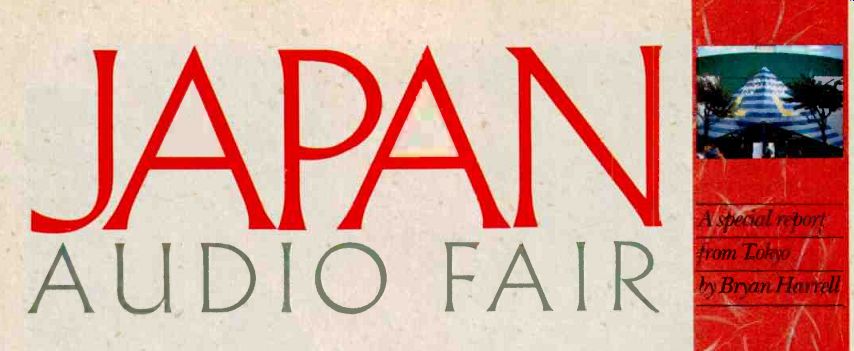
by Bryan-Harrell
---
ALTHOUGH a flood of new technology is fast transforming the world of audio, only a trickle of anything new and exciting could be seen at last October's thirty-fourth annual Japan Audio Fair. Yet the public showed an abundance of enthusiasm, with an official turnout of 283,240 visitors. It was a considerable crowd de spite the fact that the concurrent electronic parts show that in former years occupied the neighboring pavilions at the Harumi Exposition grounds was held 250 miles to the west in Osaka.
But for audio enthusiasts and industry insiders alike, the fair was even more disappointing than last year's, which was missing most of the lavish technical displays characteristic of fairs in years past. Generally, the booths and displays were hum drum, the female models were less professional (read attractive) in less imaginative outfits, and elaborate explanatory displays had been replaced with rows and rows of audio components already on sale to the public. In short, it looked like the audio departments of a hundred Japanese department stores all jammed together in jigsaw-puzzle fashion.
------------
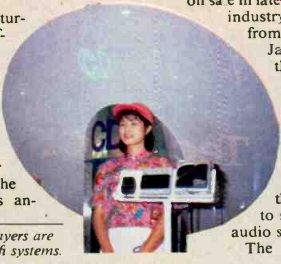
above: In Japan, portable CD players are very popular for home hi-fi systems.
With most manufacturers turning decent profits compared to the years before the Compact Disc, the continuing decline of audio-fair excitement should not be interpreted as an indication of further trouble for the industry. Rather, the transformation of this annual fair into a simple marketing exercise may convince some people of the cartelization of the once fiercely competitive Japanese audio industry.
In recent years, new audio developments have appeared in the form of new technical formats requiring industry-wide agreement This close cooperation has also helped the industry to achieve substantial economies of scale in both development and production, with the result that every audio manufacturer offers a virtually complete line of products. While dimensions, panel designs, and marketing strategies may differ from brand to brand, internal components and circuits often bear remarkable similarities.
The "division of labor" between companies is greater than ever, and the Dempa Shimbun, the largest industry trade paper, reports almost daily on new OEM (original equipment manufacturer) agreements be tween companies. It's as if a large part of the Japanese audio industry had turned into a kind of General Motors.
These conditions give some clue as to why the were so few "gee-whiz" proto type components this year. Most obviously absent were prototype DAT (digital audio tape) decks, which are still scheduled to go on sale in late 1986. According to several industry insiders, it was pressure from a strong association of Japanese domestic retailers that kept DAT away from public view. Apparently, with the fresh memory of recent lean years and many new product categories not yet matured, the retailers didn't want the expectations of something on the order of DAT to squash recently recovering audio sales.
The audio marketing climate
------------------68
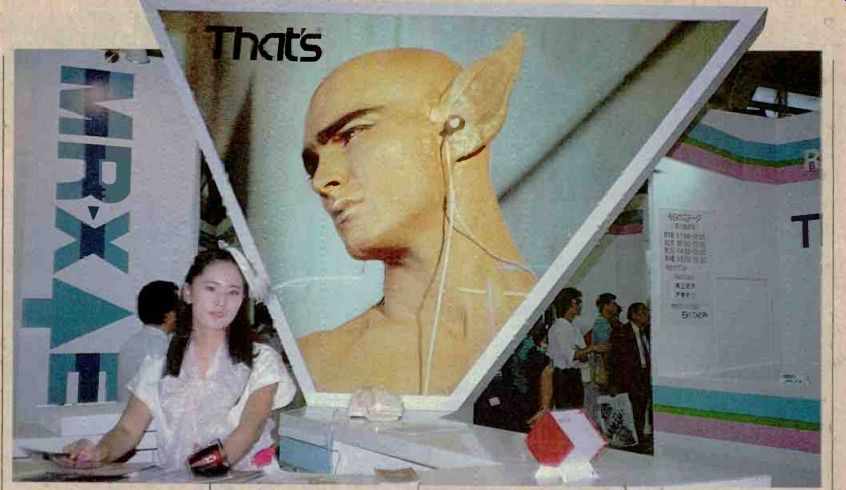
Low-priced Technics portable CD players in a rainbow of colors aroused much interest
Video Discs
Yamaha introduced two video-disc players, .xie with digital audio. TY e laser-read format has been more successful in Japan than in the U.S.A,
Golden Ears
That's bland tape cassettes (sold in the U.S. render the name Triad) featured unusual visuals in its display, prompting humorous speculations about genetic engineering to develop the perfect audiophile.
Wall of TV Video played a Digger role in this year's Audio Fair than last. A wall of TV sets greeted visitors to NEC's mostly video exhibit.
too a
Hot Tickets--Tickets to the Japan Audio Fair are available to the public, and more than a quarter of a million people attend each year
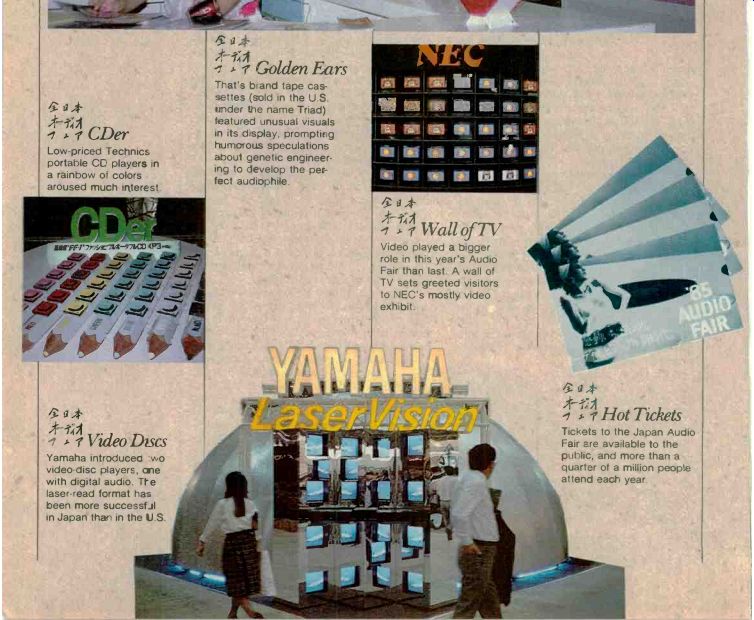
-------------------
... bears this out. Compact Disc players are just starting to penetrate the Japanese market in a major way, hi-fi video has gained a large share but still has a great sales potential, 8mm video is now perched to be next year's hot item, surround-sound processors abound, and a broad assortment of video disc players (LaserDisc and VHD) are tempting many young buyers. It is important to keep in mind that the majority of potential audio consumers, the Japanese baby-boomers in their twenties just entering the labor market, can really afford the purchase of only one or two of these new items in a year. So the last thing that retailers want consumers to think about is "The Next Big Thing." In short, the manufacturers have shown that they will only turn out new products as fast as people will buy them.
----------------------THE fair was held as usual in two huge pavilions. Outside, an enormous color video monitor flanked by an impressive sound system was used as an attention-getter, although most ignored its grainy resolution. In one pavilion, fairgoers were treated to a display of over 3,000 Compact Disc titles, and there was a huge test bench where you could listen to any of fifty new CD players on display.
High-end audio was again segregated this year, with displays at the nearby Harumi Den Hotel. Japanese fans of what is traditionally considered high-end audio invariably despise the din of the main pavilions and have little interest at all in video. As can be expected, they are a vanishing breed.
The presentation at Harumi Den was tasteful and comparatively low-key. Visitors were able to participate in listening tests of Compact Disc players and CD's themselves. There was also an in-depth seminar (in Japanese) on the finer points of DAT, courtesy of the industry association.
CD Players
Prices of CD players are continuing their downward slide, with this year's mid-priced players carrying the same price tags as last year's low-priced players. Prices fell into three categories, low (up to $280), medium (around $375), and high ($600 and up)-only marginally higher than the price rankings of turntables. (The prices in this article are approximate and are based on the exchange rate at the time of the show: 215 yen to the U.S. dollar.) The drop in prices has been made possible, in part, by production-cost reductions stemming from quantity manufacture of LSI's for CD players. Many suspect that manufacturers are taking little or no profit on the players themselves, instead using them as movers for their one-brand component systems in a highly competitive market where paces are being cut helter skelter. But the real reason for dramatically dropping prices might be found in the way almost all Japanese corporations prize long-term market share over short-term profitability.
This year, the CD-player category is stratifying according to type: component, portable, and car. While car CD will never take off until component players are firmly entrenched, portables appear to be popular with people who use them as players in their home systems. With the addition of a sixteen-track programmable memory, Sony's new D-50 Mk-II ($235) barely squeaks by as the smallest player this year, being just 4 millimeters thinner than Technics' SL-XP7 (also $235), which features a fifteen-track memory playback. Technics also displayed what appeared to be a simpler, lower-priced version (my guess is around $180) in a rainbow of colors for release in late 1985. Both of the Technics portables are advertised in Japan with the nickname "CDer" (pronounced "Shee da"--you figure it out).
Technics also showed the stylish RX CD70 ($465) three-piece portable system (you wouldn't call it a "boom box"-it's far too pretty), which has a CD player and a double autoreverse tape deck in its angled-up main unit flanked by matching two-way speakers. Sony's three-piece portable with a CD player, the CFD-5 ($500), included a single deck and a five-band graphic equalizer. And Hitachi joined the ranks of the CD portable makers with the handsome, some what larger DAD-P100 ($255), which has four-stage error correction, a three-way power supply, and several other features including a tone control! JAPANESE consumers, in particular, seem enamored of things miniature, the smaller the better. The small size and low price of CD portables make the purchase easy and less imposing, leading many to believe that it could be the portables that will allow the format to really take off, though many actually may never be used as portables per se.
In the continuing saga of sagging prices, Yamaha came in lowest this year with the $210 CD-X3 player, which features a three-beam pickup and programming functions.
Yamaha also displayed six other new players in a move to blanket all price ranges: the CD-350 ($235), the CD-100X ($280), the CD-550 with wireless remote control ($325), the CD-1000 ($550), the CD-2000 ($700). and the deluxe CD-2000W in silver (rare this year) with wood side panels ($735).

-----------
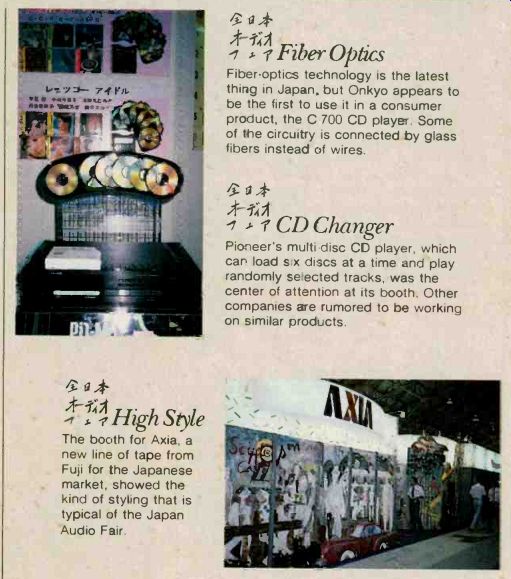
Fiber Optics
Fiber-optics technology is the latest thing in Japan. but Onkyo appears to be the first to use it in a consumer product, the C 700 CD player. Some of the circuitry is connected by glass fibers instead of wires.
CD Changer
Pioneers multi disc CD player, which can load six discs at a time and play randomly selected tracks, was the center of attention at its booth. Other companies are rumored to be working on similar products.
High Style
The booth for Axia, a new line of tape from Fuji for the Japanese market, showed the kind of styling that is typical of the Japan Audio Fair.
---------------
One of the most impressive introductions was Pioneer's PD-M6 "six pack" auto-changer CD player ($500), which can hold up to six CD's in a special cartridge [see test report]. Even more versatile was Aiwa's LDX- 1000 prototype turntable/CD player. Lift off the turntable mat of this ordinary-looking linear-tracking player and you'll find spaces for four Compact Discs, which can be played in a programmed sequence. No word yet on price or release date. Also distinctive was Onkyo's C-700 CD player ($645), which uses fiber-optics coupling to separate the digital and analog sections electrically for what the manufacturer claims is purer sound quality.
Among the new Denon releases was the $465 DCD-1500, which features separate digital filters for the two channels and a wireless remote control. The Technics SL P300 ($280) comes with a full-function wireless remote control, making it an excel lent value. Sony showed the high-end CDP 553ESD ($745), with a chassis made of a new ceramic material, and a professional-use modular CD player system made up of two CDP-3000 players ($2,095 each) and the CDS-3000 control unit. Only Sony's CDP-5000, for broadcaster use, is more expensive ($6,980). Other new entries were the NEC CD-500 ($280) with a wireless remote control that adjusts volume, the JVC XL-V200 ($270) and XL-V400 ($400), Akai's CD-A30 ($235) and CD-A70 ($375), and the Sharp DX-60 ($270) with full-function wireless remote control.
Digital Audio Tape
In addition to retailer fears of yet another product category that will have a strong effect on the cassette-deck market, CD soft ware manufacturers are apprehensive about popular-priced home digital recording systems. The availability of such systems would definitely affect CD sales adversely since there is a large number of entertainment-software outlets all over Japan that now rent out Compact Discs. If people could rent CD's and tape them, they wouldn't be as likely to buy them. Manufacturers are cooperating by holding back DAT equipment until the CD format more strongly establishes itself.
Details on the proposed format are still a little hazy. As it looks now, there will be two systems: R-DAT, using a rotating tape head, and S-DAT, using a standard tape head. It seems that R-DAT will be the pre dominant format, using cassettes slightly smaller than 8mm video. The rotating head will scan 130 diagonal tape tracks each second at an effective linear tape speed of 3.2 meters per second! That's about sixty-four times faster than the tape speed in conventional analog audio cassette decks.
DAT will operate in four modes. Model 1 will allow full 2- to 20,000-Hz frequency response, while Modes II to IV offer only a 2- to 15,000-Hz response. The most interesting aspect of the specs is the sampling frequencies chosen. Model 1 will operate at 48 kHz, the others at 32 kHz. Since the Compact Disc system samples at 44.1 kHz, direct digital recording from CD's will not be possible; copies will have to be made from the analog output. Audio fans will be disappointed, but apparently this decision was made to protect, in some small way, the property rights of recording artists. Like the CD system, however, DAT has provisions for digital subcode recording, which can allow the generation of graphic stills on a television screen. It should also be pointed out that DAT features two additional linear tracks at the edges of the tape, which might conceivably be used to record signal-access information for music sensor track-skipping and random programmable playback.

So when will DAT decks make an appearance? One optimistic Japanese audio critic has predicted that the first machines will appear in the summer or fall of 1986, with a price tag between $465 and $700. My own less optimistic view is that anxious audiophiles should not hold their breaths.
Audio/Video
As in the U.S., the raw imbecility of almost all Japanese TV programming has been instrumental in creating demand for home video. With cable TV virtually non existent in Japan, however, video-software rental outfits have come to dot neighbor hoods like tofu shops.
------------------PROMINENT items in this area were LaserDisc and 8mm video gear. While the Laser-
Disc format affords excellent sound quality, nobody seems to take 8mm video seriously as a hi-fi sound medium be cause, despite its digital recording capabilities, the ceiling on high-frequency response has been arbitrarily set at 15,000 Hz. Most listeners, however, won't notice anything missing.
The big news in LaserDisc players was smaller price tags, led by Yamaha's LV-X1 ($460) and its digital-sound version, the LV-X1 Digital ($600), and Pioneer's LD 5100 ($560), also with digital sound.
New developments in half-inch audio/ video were relatively few, probably because manufacturers are waiting for the market to mature a little more. One interesting introduction was Sony's PCM-HFIO Hi-Band Beta Hi-Fi VCR ($1,010, including wireless remote) with a built-in PCM processor for convenient digital audio recording on Beta video cassettes.
Conventional Components
Though all manufacturers had new cassette decks, amplifiers, receivers, and speakers, the newness was mostly cosmetic.
There was real activity in the sound-processor category, however. Marantz introduced the RV-55 digital sound-field controller ($550), and Akai the MM-99 ($735) sound processor with digital delay and provisions for connecting musical instruments and microphones.
IN amplifiers, the Marantz DPM-7 digital-processing amplifier ($1,630), to be re leased here in December, was a show stopper. Said to be developed jointly with Philips, it features a digitized preamp section with computer-controlled functions. The benefits are said to be "richer sound with no deterioration" and built in digital delay, reverberation, expansion, and compression processing. Direct input of digital signals from CD's or other sources is also possible. The preamplifier uses an audio signal processing LSI developed by Philips, with a digital-to-analog converter between the preamp and power-amp stages. Sampling frequency is 44.1 kHz.
Also impressive was Luxman's prototype MB300 mono power amplifier, a fantastically classic-looking component built around a huge WE-300B transmitting tube, with monstrous power, drive, and output transformers mounted on the board. Once again, "tube sound" adherents go for the traditional design approach.
In cassette decks, this could be the sleepiest year in terms of new developments since the format was established. Dolby's HX Pro headroom-extension system is gaining in popularity. It can now be found on Yamaha's new K-1XW ($645), Denon's new DR-M35H ($420), and offerings by Aiwa and Luxman. Pioneer, with the CTA9D ($675), has achieved what it claims to be the world's lowest wow-and-flutter spec (0.018 percent) for a cassette deck.
In Closing
The transformation in music reproduction that began with digital audio not so many years back has now embraced video to an even greater extent. In terms of affordable products, everything has come at the same time. The message of this year's Japan Audio Fair was that the Japanese audio industry is settling down and putting its efforts into finishing out this decade with slower product development and brisker sales of what's already on the shelf.
The U.S. versions of almost everything new at the show are already on their way, and many are arriving stateside in time for Christmas.
Also see: